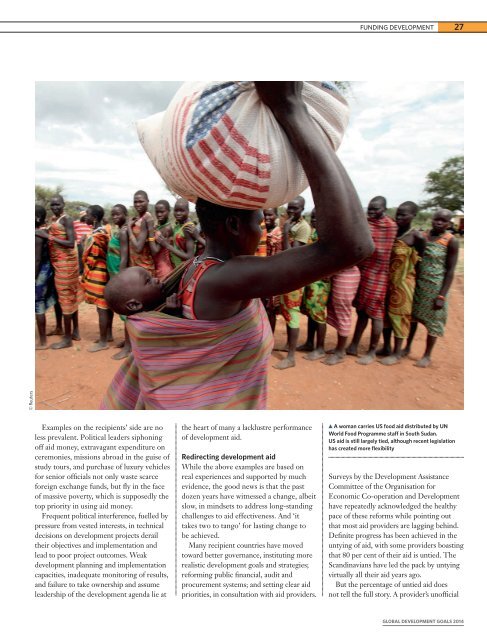FAMBB
FAMBB
FAMBB
You also want an ePaper? Increase the reach of your titles
YUMPU automatically turns print PDFs into web optimized ePapers that Google loves.
FUNDING DEVELOPMENT27© ReutersExamples on the recipients’ side are noless prevalent. Political leaders siphoningoff aid money, extravagant expenditure onceremonies, missions abroad in the guise ofstudy tours, and purchase of luxury vehiclesfor senior officials not only waste scarceforeign exchange funds, but fly in the faceof massive poverty, which is supposedly thetop priority in using aid money.Frequent political interference, fuelled bypressure from vested interests, in technicaldecisions on development projects derailtheir objectives and implementation andlead to poor project outcomes. Weakdevelopment planning and implementationcapacities, inadequate monitoring of results,and failure to take ownership and assumeleadership of the development agenda lie atthe heart of many a lacklustre performanceof development aid.Redirecting development aidWhile the above examples are based onreal experiences and supported by muchevidence, the good news is that the pastdozen years have witnessed a change, albeitslow, in mindsets to address long-standingchallenges to aid effectiveness. And ‘ittakes two to tango’ for lasting change tobe achieved.Many recipient countries have movedtoward better governance, instituting morerealistic development goals and strategies;reforming public financial, audit andprocurement systems; and setting clear aidpriorities, in consultation with aid providers.A woman carries US food aid distributed by UNWorld Food Programme staff in South Sudan.US aid is still largely tied, although recent legislationhas created more flexibilitySurveys by the Development AssistanceCommittee of the Organisation forEconomic Co-operation and Developmenthave repeatedly acknowledged the healthypace of these reforms while pointing outthat most aid providers are lagging behind.Definite progress has been achieved in theuntying of aid, with some providers boastingthat 80 per cent of their aid is untied. TheScandinavians have led the pack by untyingvirtually all their aid years ago.But the percentage of untied aid doesnot tell the full story. A provider’s unofficialGLOBAL DEVELOPMENT GOALS 2014


